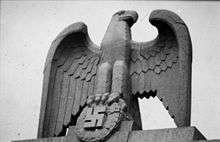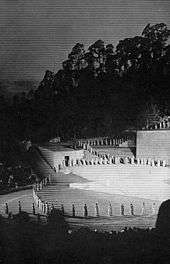Nazi architecture
Nazi architecture is the architecture of the Third Reich, 1933-1945. It is characterized by three forms: a stripped-down NeoClassicism (typified by the designs of Speer); a vernacular style that drew inspiration from traditional rural architecture, especially alpine; and a utilitarian style followed for major infrastructure projects and industrial or military complexes. Nazi ideology took a pluralist attitude to architecture; however, Hitler himself believed that form should follow function and wrote against "stupid imitations of the past".[1]

Nazi eagle and swastika, Berlin, 1940
See also
General
Architects
References
- ↑ Nazi architecture, in "Oxford Dictionary of Architecture and Landscape Architecture", 2006, p518.
Further reading
Books
- Baynes, Norman H., ed. (1942). The Speeches of Adolf Hitler, April 1922-August 1939. Two vols. London: Oxford University Press.
- Brenner, Hildegard (1965). La politica culturale del nazismo [Die Kunstpolitik des Nationalsozialismus (Art policies of Nazism)] (in Italian). Translated from German by Enzo Collotti. Bari: Laterza.
- Cowdery, Ray; Cowdery, Josephine (2003). The New German Reichschancellery in Berlin 1938-1945. Victory WW2 Publishing. ISBN 978-0910667289.
- De Jaeger, Charles (1981). The Linz file: Hitler's plunder of Europe's art. Exeter: Webb & Bower. ISBN 9780906671306.
- Dülffer, Jost; Thies, Jochen; Henke, Josef (1978). Hitlers Städte: Baupolitik Im Dritten Reich. Eine Dokumentation [Building Policies in the Third Reich] (in German). Köln: Böhlau. ISBN 3-412-03477-0.
- Giesler, Hermann (1977). Ein Anderer Hitler: Bericht Seines Architekten Erlebnisse, Gesprache, Reflexionen [A Different Hitler: Report on its Architects' Experiences, Conversations, Reflections] (in German). Druffel. ISBN 978-3806108200.
- Helmer, Stephen (1985). Hitler's Berlin: The Speer Plans for Reshaping the Central City (Illustrated). Ann Arbor: UMI Research Press. ISBN 0-8357-1682-1.
- Hitler, Adolf (1971). Mein Kampf [My Struggle]. Translated by Ralph Manheim. Houghton Mifflin. ISBN 978-0395078013. In Internet Archive (1941 edition by Reynal & Hitchcock, New York).
- Hitler, Adolf (2000). Hitler's Table Talk 1941-1944: His Private Conversations. Translated by Norman Cameron and R.H. Stevens. New York: Enigma Books. ISBN 1-929631-05-7.
- Homze, Edward L. (1967). Foreign Labor in Nazi Germany. Princeton University Press. ISBN 0-691-05118-6.
- Jaskot, Paul B. (2000). The Architecture of Oppression: The SS, Forced Labor and the Nazi Monumental Building Economy. New York: Routledge. ISBN 978-0415223-416.
- Krier, Leon (1989). Albert Speer Architecture. New York: Princeton Architectural Press. ISBN 2-87143-006-3.
- Lärmer, Karl (1975). Autobahnbau in Deutschland 1933 bis 1945 [Highway construction in Germany 1933-1945] (in German). Berlin: Akademie Verlag. ASIN B001UWP0DY.
- Lehmann-Haupt, Hellmut (1973). Art under a Dictatorship (Illustrated). New York: Octagon Books. ISBN 0-374-94896-8.
- Lehrer, Steven (2006). The Reich Chancellery and Fuhrerbunker Complex: An Illustrated History of the Seat of the Nazi Regime. McFarland & Co. ISBN 978-0786423934.
- Mittig, Hans-Ernst (2005). "Marmor der Reichskanzlei". In Bingen, Dieter; Hinz, Hans-Martin. Die Schleifung: Zerstörung und Wiederaufbau historischer Bauten in Deutschland und Polen [The Razing: Destruction and Reconstruction of Historical Buildings in Germany and Poland] (in German). Wiesbaden: Otto Harrassowitz. ISBN 3-447-05096-9.
- Nerdinger, Winfried (1999). Bauhaus-Moderne im Nationalsozialismus [Modernist Architecture in Nazi Germany] (in German). Prestel. ISBN 978-3791312699.
- Petsch, Joachim (1976). Baukunst Und Stadtplanung Im Dritten Reich: Herleitung, Bestandsaufnahme, Entwicklung, Nachfolge [Architecture and urban planning in the Third Reich: Origin, Inventory, Development, Follow-up] (in German). C. Hanser. ISBN 978-3446122796.
- Rittich, Werner (1938). Architektur und Bauplastik der Gegenwart [Plastic Figures in Modern Architecture] (in German). Berlin: Rembrandt Verlag.
- Schönberger, Angela (1981). Die Neue Reichskanzlei von Albert Speer. Zum Zusammenhang von nationalsozialistischer Ideologie und Architektur [The New Reich Chancellery by Albert Speer. To a Coherence between Nazi Ideology and Architecture] (in German). Berlin: Gebrüder Mann. ISBN 978-3786112631.
- Scobie, Alexander (1990). Hitler's State Architecture: The Impact of Classical Antiquity. College Art Association Monograph - Book 45. Pennsylvania State University Press. ISBN 978-0271006918.
- Schmitz, Matthias (1940). A Nation Builds: Contemporary German Architecture. New York: German Library of Information. Lay summary – questia.
- Speer, Albert (1970). Inside the Third Reich. Translation by Richard and Clara Winston. New York: Macmillan. ISBN 0-02-037500-X. In Internet Archive.
- Spotts, Frederic (2002). Hitler and the Power of Aesthetics. Woodstock, New York: Overlook Press. ISBN 1-58567-345-5.
- Taylor, Robert (1974). The Word in Stone: The Role of Architecture in the National Socialist Ideology. Berkeley: University of California Press. ISBN 0-520-02193-2.
- Thies, Jochen (1976). Architekt der Weltherrschaft. Die Endziele Hitlers [Architect of world domination. The ultimate goals of Hitler] (in German). Düsseldorf: Droste. ISBN 978-3770004256.
- Zoller, Albert (1949). Hitler privat. Erlebnisbericht seiner Geheimsekretärin [Hitler's Private Secretary Testimony] (in German). Düsseldorf: Droste. ASIN B0023S7QZO.
External links
 Media related to Nazi architecture at Wikimedia Commons
Media related to Nazi architecture at Wikimedia Commons
Articles
- A Theory of Ruin-value , Cornelius Holtorf, last updated on 21 December 2004.
- Vienna. Pearl of the Reich. Planning for Hitler Exhibition at Architechturzentrum Wien 2015
Images
- "Image Galleries: Albert Speer". Berlin: the city as body, the city as metaphor.
- A Teacher's Guide to the Holocaust website:
Miscellanea
- Axis History Forum: Architecture
- Third Reich In Ruins
- Bunker in Hamburg
- NS-Architektur at LEMO - Lebendiges Museum Online.
- Traces of Evil: Remaining Nazi sites in Germany.
- Third Reich locations: Pictorial information about locations connected historically to the Third Reich.
This article is issued from Wikipedia - version of the 11/2/2016. The text is available under the Creative Commons Attribution/Share Alike but additional terms may apply for the media files.

